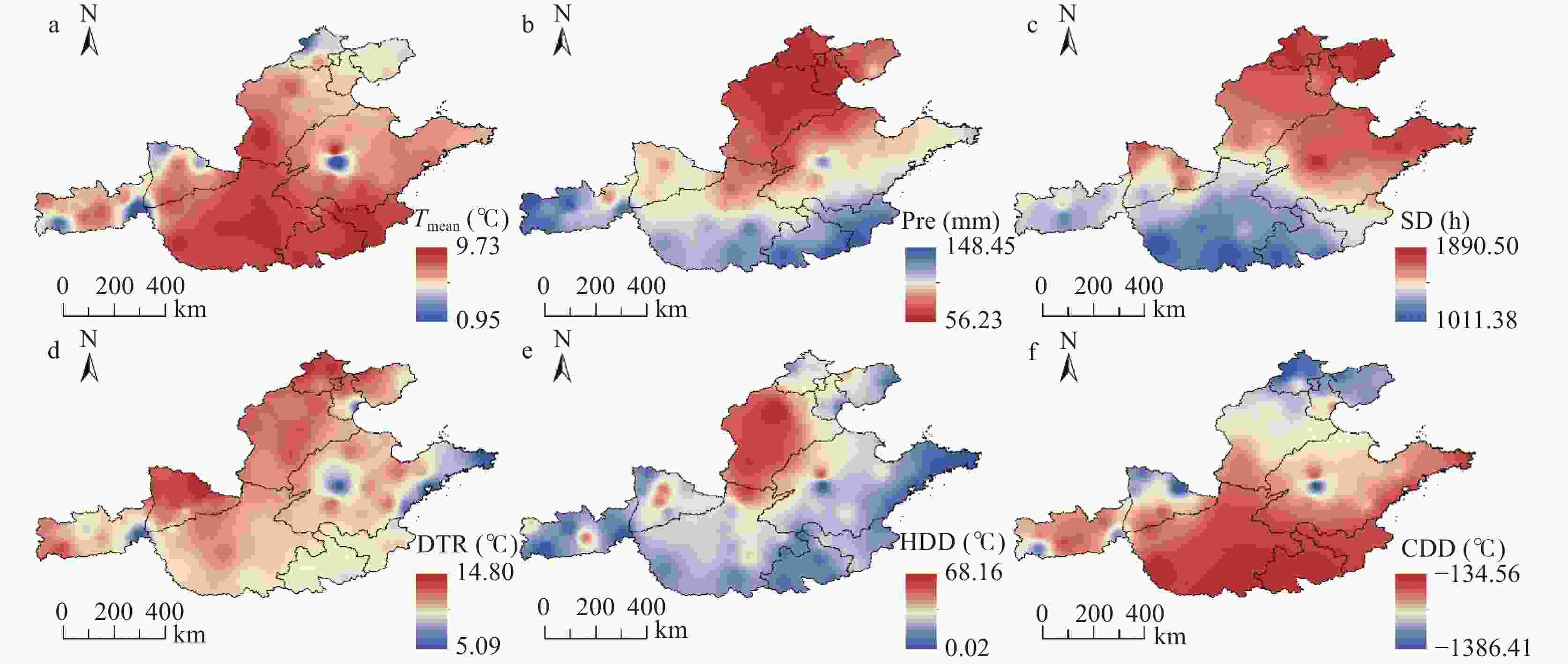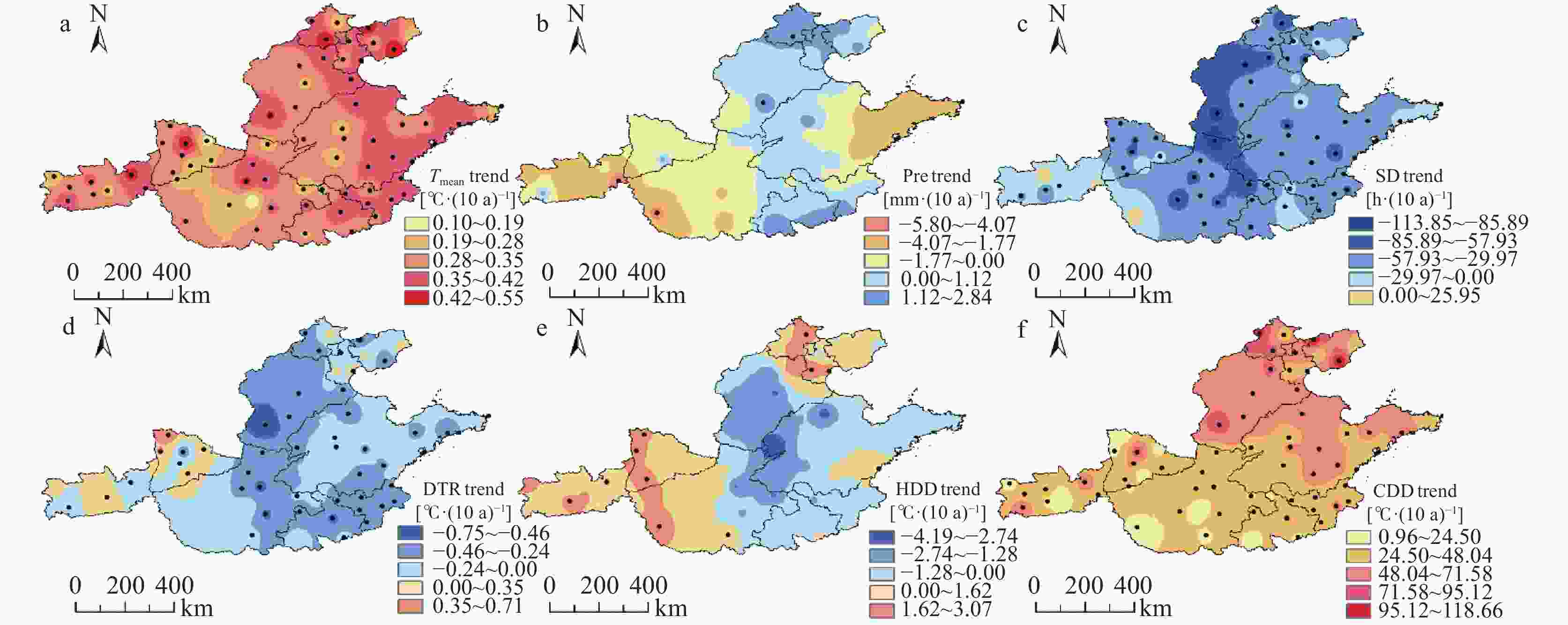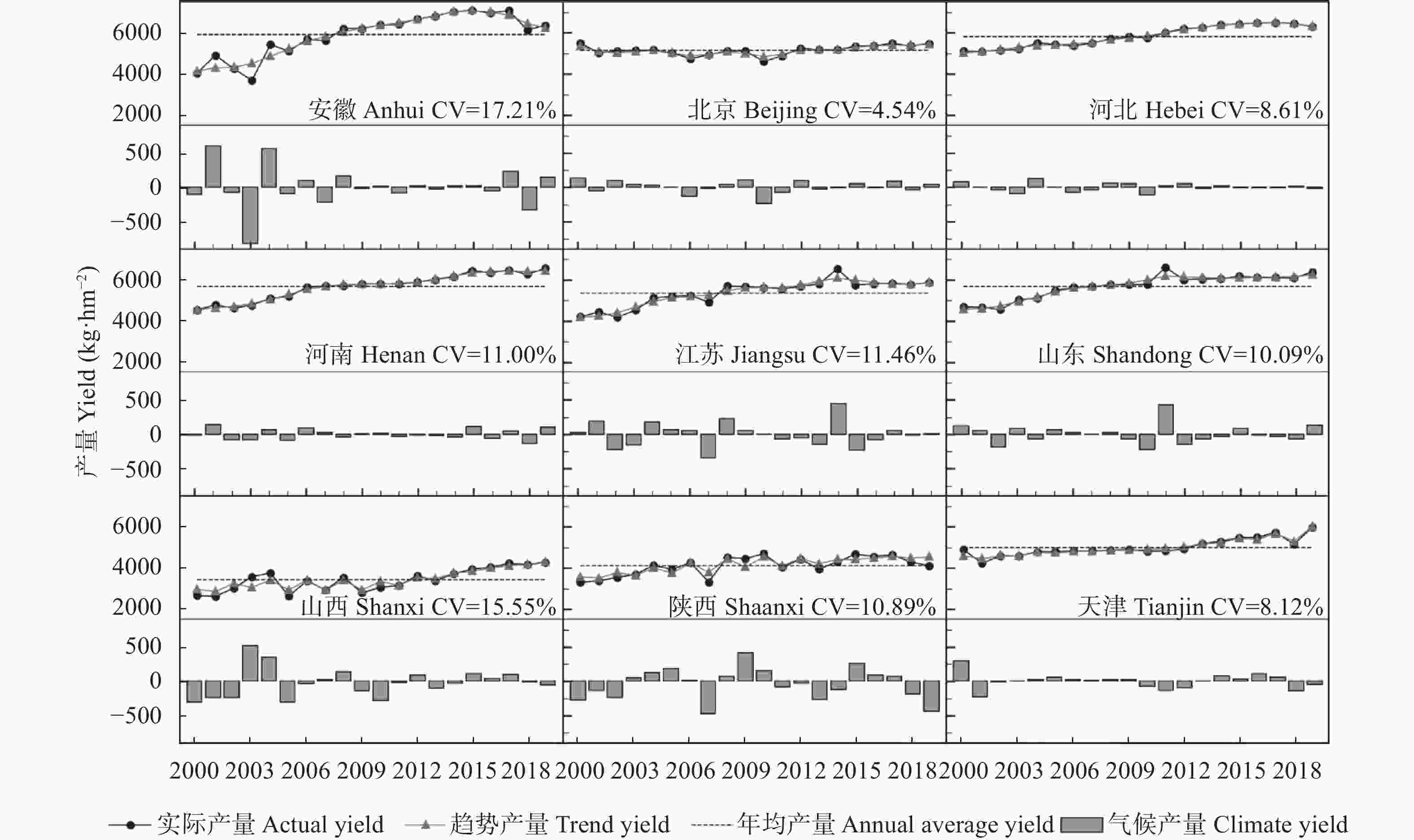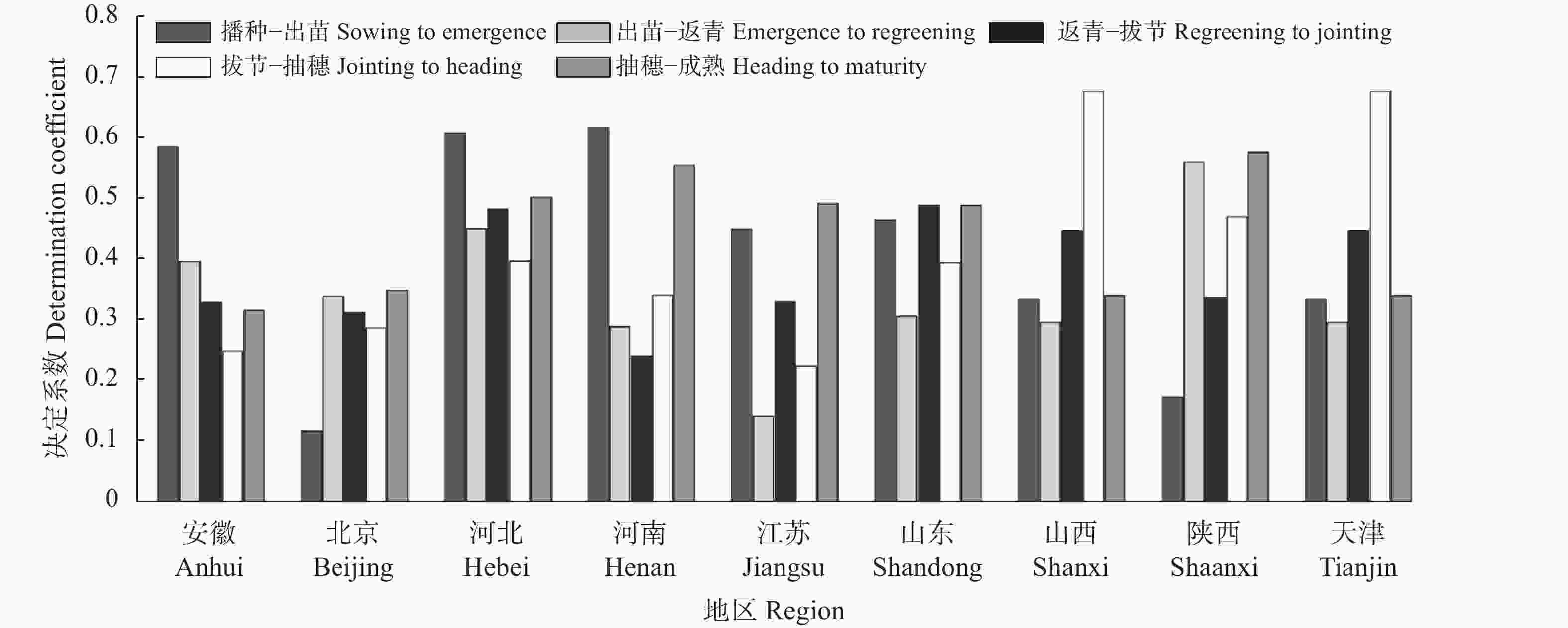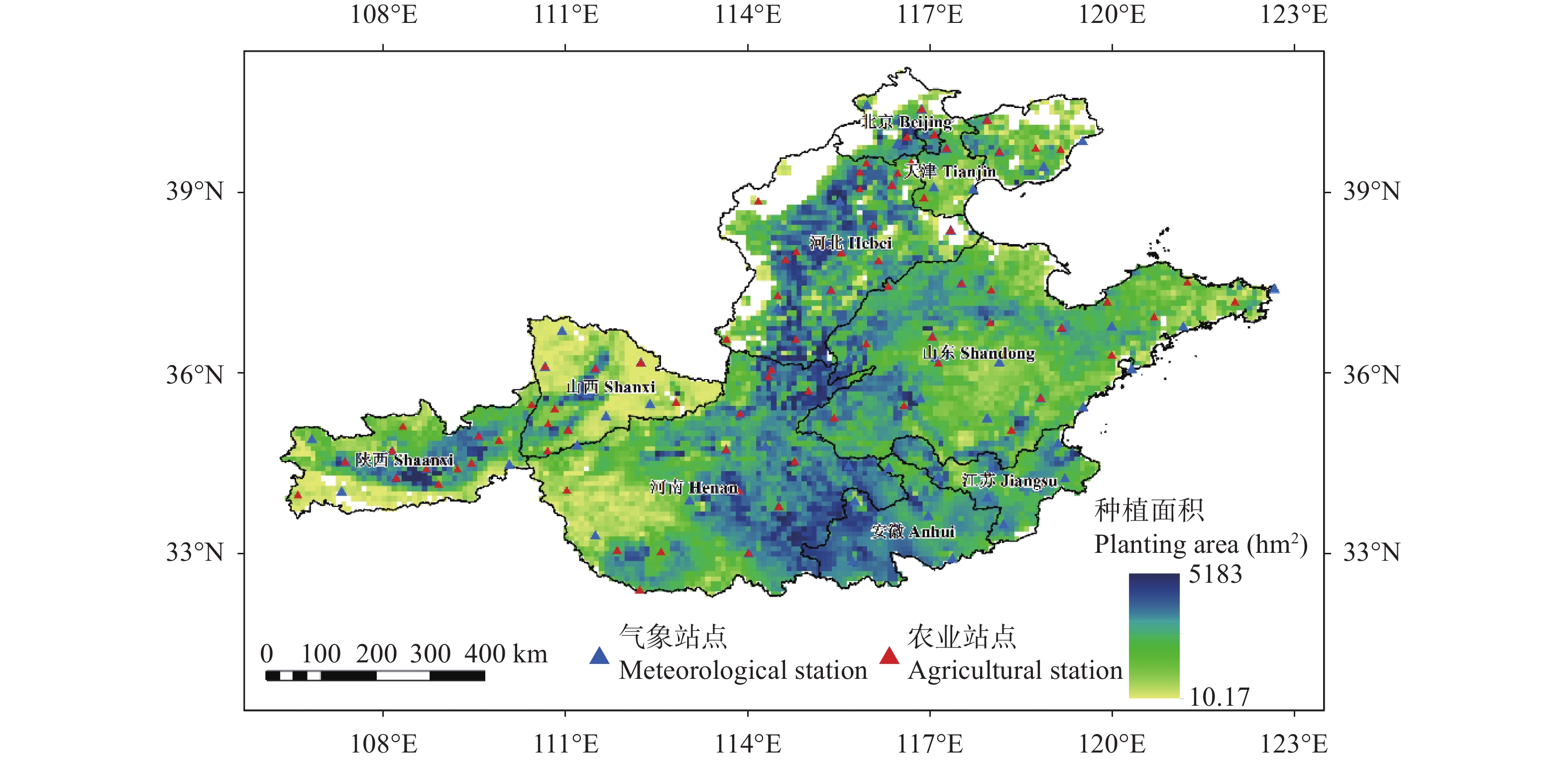Climate change and its effect on winter wheat yield in the main winter wheat production areas of China
-
摘要: 气候变化对农业生产具有重要影响, 明确影响作物产量的关键生育期和限制性气象因子对保障粮食安全具有重要意义。本文基于气象站点和农业站点的观测数据及产量数据, 采用趋势分析法和线性回归法分析了1960—2019年我国冬小麦主产区气象因子的时空分布特征, 解析了产量与气象因子间的回归关系, 确定了典型低产年影响产量的关键生育期和限制性气象因子。结果表明: 1) 1960—2019年, 冬小麦主产区平均温度、有效降水和冷积温(日最低气温低于0 ℃的积温)的分布大致呈南高北低, 而日照时数、气温日较差和热积温(日最高气温高于30 ℃的积温)为北高南低; 平均气温和冷积温呈显著上升趋势, 日照时数和气温日较差显著下降, 有效降水和热积温的变化趋势无明显特征。2) 2000—2019年, 中国冬小麦主产区小麦年均单产为3426~5910 kg∙hm−2, 各省(市)冬小麦产量均呈显著上升趋势(P<0.05); 气象因子对产量贡献率的排序为气温日较差>日照时数>有效降水>冷积温>平均气温>热积温。3)典型低产年, 抽穗至成熟期是气候因子影响产量的关键时期, 限制性气象因子为有效降水、日照时数和气温日较差。综上, 中国冬小麦主产区气候因子的分布特征和变化趋势存在空间异质性, 在气候变化背景下, 应关注气温日较差、日照时数和有效降水对冬小麦生长的影响, 同时重点关注冬小麦抽穗至成熟期上述气象因子对产量的不利影响。Abstract: Climate change plays an important role in crop growth and grain yield. Therefore, there is an urgent need to understand the distribution characteristics and changing trends of climatic factors in the main crop production areas. Furthermore, analyzing the impact of meteorological factors at different crop growth stages is of great significance for maintaining food security and agricultural disaster prevention. In this study, the spatial distribution and variation trends of six critical meteorological factors during the winter wheat growing season in the main winter wheat production areas of China were investigated based on meteorological and phenological data from 69 meteorological and 77 agricultural stations located in the study area. The relationship between winter wheat yield fluctuation and meteorological factors was explored using a multiple regression model. The changing characteristics of meteorological factors in a typical low-yield year was evaluated to identify the key growth stage for winter wheat and the restrictive meteorological factors in the study area. The results showed the following: 1) From 1960 to 2019, the spatial distribution of meteorological factors in the main winter wheat production areas of China was uneven and the variation trends were different. The mean temperature (Tmean), effective precipitation (Pre), and cooling degree days (CDD, the accumulated temperature for daily minimum temperature below 0 ℃) were higher in the southern regions, including Jiangsu Province, Anhui Province, and Henan Province; whereas the sunshine duration (SD), daily temperature range (DTR), and heating degree days (HDD, the accumulated temperature for daily maximum temperature above 30 ℃) were higher in the northern regions, such as Hebei Province, Shandong Province, Beijing, and Tianjin. The Tmean and CDD showed significant increasing trends with average rates of 0.33 ℃∙(10a)−1 and 43.42 ℃∙(10a)−1, respectively; whereas the SD and DTR significantly decreased at rates of 42.30 h∙(10a)−1 and 0.17 ℃∙(10a)−1, and the Pre and HDD trends were spatially heterogenous. 2) The average annual winter wheat yield in different provinces and cities ranged from 3426 kg∙hm−2 to 5910 kg∙hm−2 with significantly increasing trends (P < 0.05), but the interannual fluctuation was large in most regions. The determination coefficient for the effect of meteorological factors on winter wheat yield ranged from 0.15 to 0.80, and the winter wheat yield in Shaanxi Province was most affected by climate change (P < 0.05). Over the whole growth period, the ranking of the meteorological factor’s contribution rate to yield was DTR > SD > Pre > CDD > Tmean > HDD. 3) In a typical low-yield year, the key winter wheat growth period was from heading to maturity, and the restrictive meteorological factors during this period were SD, DTR, and Pre. Therefore, future agricultural management and wheat breeding programs must consider the current distribution characteristics and trends of meteorological factors for improving the winter wheat productivity. More importantly, we should pay special attention to restrictive meteorological factors, such as Pre, SD, and DTR, during the critical growing stage of winter wheat from heading to maturity so that it can better cope with meteorological disasters.
-
Key words:
- Climate change /
- Winter wheat /
- Climate yield /
- Meteorological factors /
- Sunshine duration /
- Daily temperature range
-
图 2 中国冬小麦主产区1960—2019年冬小麦生长季气象因子多年均值的空间分布
Tmean : 平均气温; Pre: 有效降水; SD: 日照时数; DTR: 气温日较差; HDD: 热积温; CDD: 冷积温。Tmean: mean temperature; Pre: effective precipitation; SD: sunshine duration; DTR: daily temperature range; HDD: heating degree days; CDD: cooling degree days.
Figure 2. Spatial distribution of annual average values of meteorological factors during winter wheat growing season from 1960 to 2019 in the main winter wheat production areas of China
图 3 中国冬小麦主产区1960—2019年冬小麦生长季气象因子的变化趋势
Tmean : 平均气温; Pre: 有效降水; SD: 日照时数; DTR: 气温日较差; HDD: 热积温; CDD: 冷积温; 黑点为变化趋势通过显著性检验的站点(P<0.05)。Tmean: mean temperature; Pre: effective precipitation; SD: sunshine duration; DTR: daily temperature range; HDD: heating degree days; CDD: cooling degree days. The black points represent the stations where the meteorological factor changed significantly (P<0.05).
Figure 3. Trends of meteorological factors during winter wheat growing season from 1960 to 2019 in the main winter wheat production areas of China
图 4 中国冬小麦主产区各地1960—2019年冬小麦实际产量、年均产量、趋势产量、气候产量及产量变异系数
CV: 变异系数。CV: coefficient of variation.
Figure 4. Actual yield, annual average yield, trend yield, climatic yield and the coefficients of variation of winter wheat from 1960 to 2019 in different regions of the main winter wheat production areas of China
表 1 中国冬小麦主产区冬小麦生育阶段(月-日)划分
Table 1. Division of winter wheat growth stages (month-day) in the main winter wheat production areas of China
区域
Region生育阶段 Growth stage 播种—出苗
Sowing to
emergence出苗—返青(次年)
Emergence to regreening
(next year)返青—拔节
Regreening
to jointing拔节—抽穗
Jointing to
heading抽穗—成熟
Heading to
maturity生长季长度
Growing season
duration (d)安徽 Anhui 10-12—11-01 11-01—03-01 03-01—03-21 03-21—04-11 04-11—05-21 212 北京 Beijing 10-04—10-15 10-15—03-04 03-04—04-13 04-13—05-03 05-03—06-10 249 河北 Hebei 10-06—10-15 10-15—03-05 03-05—04-14 04-14—05-04 05-04—06-13 250 河南 Henan 10-15—10-24 10-24—02-17 02-17—03-20 03-20—04-14 04-14—05-29 226 江苏 Jiangsu 10-14—10-23 10-23—02-22 02-22—04-02 04-02—04-25 04-25—06-07 236 山东 Shandong 10-10—10-20 10-20—02-23 02-23—04-05 04-05—04-27 04-27—06-10 242 山西 Shanxi 10-08—10-18 10-18—02-23 02-23—03-29 03-29—04-24 04-24—06-07 242 陕西 Shaanxi 10-03—10-14 10-14—02-27 02-27—04-08 04-08—04-27 04-27—06-07 247 天津 Tianjin 10-04—10-14 10-14—02-20 02-20—04-13 04-13—04-29 04-29—06-05 244 表 2 冬小麦生长季气候产量归因分析
Table 2. Attribution analysis of climatic yield in winter wheat growing season
地区
Region决定系数
Determination coefficient (R2)贡献率 Contribution rate (%) Tmean Pre SD DTR HDD CDD 安徽 Anhui 0.48 9.65 17.86 24.35 20.31 1.56 26.27 北京 Beijing 0.49 37.37 32.09 6.72 12.55 5.39 5.88 河北 Hebei 0.45 3.98 4.90 36.87* 26.26 10.01 17.98 河南 Henan 0.26 0.88 15.72 24.75 28.94 11.43 18.28 江苏 Jiangsu 0.26 28.06 14.41 0.52 17.61 9.71 29.68 山东 Shandong 0.46 25.05 27.46 9.92 24.38 11.89 1.31 山西 Shanxi 0.24 9.62 39.71 23.01 18.16 3.07 6.43 陕西 Shaanxi 0.80* 0.83 32.31* 33.18* 22.63* 0.36 10.69 天津 Tianjin 0.15 20.54 6.53 26.42 40.74 4.15 1.62 Tmean : 平均气温; Pre: 有效降水; SD: 日照时数; DTR: 气温日较差; HDD: 热积温; CDD: 冷积温; *表示气候因子贡献率通过显著性检验(P<0.05)。Tmean: mean temperature; Pre: effective precipitation; SD: sunshine duration; DTR: daily temperature range; HDD: heating degree days; CDD: cooling degree days; * represents that the attribution of meteorological factor is significant (P<0.05). 表 3 中国冬小麦主产区气象因子对气候产量波动贡献率排序
Table 3. Ranking of contribution rates of meteorological factors to climatic yield of winter wheat in the main winter wheat production areas of China
生育阶段 Growth stage 贡献率排序 Ranking of contribution rate 播种—出苗 Sowing to emergence DTR>SD>Tmean>Pre>CDD>HDD 出苗—返青 Emergence to regreening CDD>DTR>SD>Pre> Tmean >HDD 返青—拔节 Regreening to jointing Pre>DTR>SD>CDD> Tmean >HDD 拔节—抽穗 Jointing to heading DTR>SD>Pre> Tmean >HDD>CDD 抽穗—成熟 Heading to maturity DTR> Tmean >HDD>SD>Pre>CDD 全生育期 Whole growing season DTR>SD>Pre>CDD> Tmean >HDD Tmean : 平均气温; Pre: 有效降水; SD: 日照时数; DTR: 气温日较差; HDD: 热积温; CDD: 冷积温。Tmean: mean temperature; Pre: effective precipitation; SD: sunshine duration; DTR: daily temperature range; HDD: heating degree days; CDD: cooling degree days. 表 4 中国冬小麦主产区典型低产年冬小麦不同生长阶段气象因子与多年均值对比
Table 4. Comparison of meteorological factors in the typical low yield year with multi-year averages in different growth periods of winter wheat in the main winter wheat production areas of China
区域 Region 生育阶段 Growth stage 播种—出苗
Sowing to
emergence出苗—返青(次年)
Emergence to regreening
(next year)返青—拔节
Regreening to
jointing拔节—抽穗
Jointing to
heading抽穗—成熟
Heading to
maturity安徽 Anhui DTR(+) ↓2.12 ℃ / / SD(+)↓16.82 h Pre(−) ↑27.23 mm
SD(+) ↓145.02 h
DTR(+)↓2.69 ℃北京 Beijing / / / / DTR(+) ↑0.31 ℃ 河北 Hebei / Tmean(−) ↑1.72 ℃ / SD(+) ↓21.53 h / 河南 Henan / SD(−) ↑75.37 h / / Pre(−) ↑23.30 mm 江苏 Jiangsu DTR(+) ↓2.22 ℃ SD(−) ↑45.03 h Tmean (−) ↑1.97 ℃
SD(+) ↓27.50 hDTR(+) ↓1.67 ℃ SD(+) ↓65.85 h
HDD(−) ↑15.50 ℃山东 Shandong / Pre(+) ↓13.34 mm / / Pre(−) ↑13.63 mm 陕西 Shaanxi / / / / SD(+) ↓66.36 h 山西 Shanxi / / / DTR(+) ↓2.15 ℃ DTR(+) ↓1.46 ℃
HDD(−) ↑10.12 ℃天津 Tianjin / / / SD(+) ↓22.24 h / Tmean: 平均气温; Pre: 有效降水; SD: 日照时数; DTR: 气温日较差; HDD: 热积温; CDD: 冷积温; (+): 气象因子的回归系数为正; (−): 气象因子的回归系数为负; ↑: 典型低产年气象因子较多年均值偏高; ↓: 典型低产年气象因子较多年均值偏低; / 表示典型低产年气象因子与多年均值差异不大。Tmean: mean temperature; Pre: effective precipitation; SD: sunshine duration; DTR: daily temperature range; HDD: heating degree days; CDD: cooling degree days. (+): the meteorological factor’s regression coefficient is positive, (−): the meteorological factor’s regression coefficient is negative; ↑: the meteorological factor of typical low yield year is higher than the multi-year average; ↓: the meteorological factor of typical low yield year is lower than the multi-year average; /: there was no significant difference between the meteorological factor of typical low yield year and the multi-year average. -
[1] IPCC. Climate Change 2013: The Physical Science Basis[R]. Cambridge: Cambridge University Press, 2013: 187–194 [2] IPCC. Climate Change 2021: The Physical Science Basis [R/OL]. IPCC. [2021-08-01]. https://www.ipcc.ch/report/ar6/wg1/ [3] 刘立涛, 刘晓洁, 伦飞, 等. 全球气候变化下的中国粮食安全问题研究[J]. 自然资源学报, 2018, 33(6): 927−939 doi: 10.31497/zrzyxb.20180436LIU L T, LIU X J, LUN F, et al. Research on China’s food security under global climate change background[J]. Journal of Natural Resources, 2018, 33(6): 927−939 doi: 10.31497/zrzyxb.20180436 [4] MURRAY-TORTAROLO G N, JARAMILLO V J, LARSEN J. Food security and climate change: the case of rainfed maize production in Mexico[J]. Agricultural and Forest Meteorology, 2018, 253/254: 124−131 doi: 10.1016/j.agrformet.2018.02.011 [5] MSOWOYA K, MADANI K, DAVTALAB R, et al. Climate change impacts on maize production in the warm heart of Africa[J]. Water Resources Management, 2016, 30(14): 5299−5312 doi: 10.1007/s11269-016-1487-3 [6] PEÑA-BAUTISTA R J, HERNANDEZ-ESPINOSA N, JONES J M, et al. CIMMYT series on carbohydrates, wheat, grains, and health: wheat-based foods: their global and regional importance in the food supply, nutrition, and health[J]. Cereal Foods World, 2017, 62(5): 231−249 doi: 10.1094/CFW-62-5-0231 [7] 赵广才, 常旭虹, 王德梅, 等. 中国小麦生产发展潜力研究报告[J]. 作物杂志, 2012(3): 1−5ZHAO G C, CHANG X H, WANG D M, et al. Research report on development of China’s wheat production potential[J]. Crops, 2012(3): 1−5 [8] LOBELL D B, SCHLENKER W, COSTA-ROBERTS J. Climate trends and global crop production since 1980[J]. Science, 2011, 333(6042): 616−620 doi: 10.1126/science.1204531 [9] ASSENG S, EWERT F, MARTRE P, et al. Rising temperatures reduce global wheat production[J]. Nature Climate Change, 2015, 5(2): 143−147 doi: 10.1038/nclimate2470 [10] DWIVEDI S K, BASU S, KUMAR S, et al. Heat stress induced impairment of starch mobilisation regulates pollen viability and grain yield in wheat: study in Eastern Indo-Gangetic Plains[J]. Field Crops Research, 2017, 206: 106−114 doi: 10.1016/j.fcr.2017.03.006 [11] LOBELL D B, SIBLEY A, IVAN ORTIZ-MONASTERIO J. Extreme heat effects on wheat senescence in India[J]. Nature Climate Change, 2012, 2(3): 186−189 doi: 10.1038/nclimate1356 [12] 孟繁圆, 冯利平, 张丰瑶, 等. 北部冬麦区冬小麦越冬冻害时空变化特征[J]. 作物学报, 2019, 45(10): 1576−1585MENG F Y, FENG L P, ZHANG F Y, et al. Temporal and spatial variations of winter wheat freezing injury in northern winter wheat region[J]. Acta Agronomica Sinica, 2019, 45(10): 1576−1585 [13] LE GOUIS J, OURY F X, CHARMET G. How changes in climate and agricultural practices influenced wheat production in western Europe[J]. Journal of Cereal Science, 2020, 93: 102960 doi: 10.1016/j.jcs.2020.102960 [14] 戴彤, 王靖, 赫迪, 等. 1961—2010年气候变化对西南冬小麦潜在和雨养产量影响的模拟分析[J]. 中国生态农业学报, 2016, 24(3): 293−305DAI T, WANG J, HE D, et al. Impact simulation of climate change on potential and rainfed yields of winter wheat in Southwest China from 1961 to 2010[J]. Chinese Journal of Eco-Agriculture, 2016, 24(3): 293−305 [15] 李文旭, 吴政卿, 雷振生, 等. 河南省主要气象因子变化及其对主要粮食作物单产的影响特征[J]. 作物杂志, 2021(1): 124−134LI W X, WU Z Q, LEI Z S, et al. The characteristics of climate factors change and its effects on main grain crops yield per unit area in Henan Province[J]. Crops, 2021(1): 124−134 [16] 杨文彪, 张慧芋, 李莹, 等. 山西省冬小麦生产潜力时空分布与气象因子分析[J]. 作物杂志, 2020(1): 161−167YANG W B, ZHANG H Y, LI Y, et al. Spatiotemporal distribution of potential productivity of winter wheat and meteorological factor analysis in Shanxi Province[J]. Crops, 2020(1): 161−167 [17] 董旭光, 李胜利, 石振彬, 等. 近50年山东省农业气候资源变化特征[J]. 应用生态学报, 2015, 26(1): 269−277DONG X G, LI S L, SHI Z B, et al. Change characteristics of agricultural climate resources in recent 50 years in Shandong Province, China[J]. Chinese Journal of Applied Ecology, 2015, 26(1): 269−277 [18] 肖登攀, 陶福禄, 沈彦俊, 等. 华北平原冬小麦对过去30年气候变化响应的敏感性研究[J]. 中国生态农业学报, 2014, 22(4): 430−438XIAO D P, TAO F L, SHEN Y J, et al. Sensitivity of response of winter wheat to climate change in the North China Plain in the last three decades[J]. Chinese Journal of Eco-Agriculture, 2014, 22(4): 430−438 [19] 李祎君, 王春乙. 气候变化对我国农作物种植结构的影响[J]. 气候变化研究进展, 2010, 6(2): 123−129LI Y J, WANG C Y. Impacts of climate change on crop planting structure in China[J]. Advances in Climate Change Research, 2010, 6(2): 123−129 [20] 杨晓光, 刘志娟, 陈阜. 全球气候变暖对中国种植制度可能影响 Ⅰ. 气候变暖对中国种植制度北界和粮食产量可能影响的分析[J]. 中国农业科学, 2010, 43(2): 329−336 doi: 10.3864/j.issn.0578-1752.2010.02.013YANG X G, LIU Z J, CHEN F. The possible effects of global warming on cropping systems in China Ⅰ. the possible effects of climate warming on northern limits of cropping systems and crop yields in China[J]. Scientia Agricultura Sinica, 2010, 43(2): 329−336 doi: 10.3864/j.issn.0578-1752.2010.02.013 [21] 杨晓光, 刘志娟, 陈阜. 全球气候变暖对中国种植制度可能影响: Ⅵ. 未来气候变化对中国种植制度北界的可能影响[J]. 中国农业科学, 2011, 44(8): 1562−1570 doi: 10.3864/j.issn.0578-1752.2011.08.004YANG X G, LIU Z J, CHEN F. The possible effects of global warming on cropping systems in China Ⅵ. Possible effects of future climate change on northern limits of cropping system in China[J]. Scientia Agricultura Sinica, 2011, 44(8): 1562−1570 doi: 10.3864/j.issn.0578-1752.2011.08.004 [22] PORTMANN F T, SIEBERT S, DÖLL P. MIRCA2000-Global monthly irrigated and rainfed crop areas around the year 2000: a new high-resolution data set for agricultural and hydrological modeling[J]. Global Biogeochemical Cycles, 2010, 24(1): GB1011 [23] 赵广才. 中国小麦种植区划研究(一)[J]. 麦类作物学报, 2010, 30(5): 886−895ZHAO G C. Study on Chinese wheat planting regionalization (Ⅰ)[J]. Journal of Triticeae Crops, 2010, 30(5): 886−895 [24] 赵广才. 中国小麦种植区划研究(二)[J]. 麦类作物学报, 2010, 30(6): 1140−1147 doi: 10.7606/j.issn.1009-1041.2010.06.030ZHAO G C. Study on Chinese wheat planting regionalization(Ⅱ)[J]. Journal of Triticeae Crops, 2010, 30(6): 1140−1147 doi: 10.7606/j.issn.1009-1041.2010.06.030 [25] 郑永丹. 中国主要粮食作物生育期时空格局及其变化[D]. 武汉: 华中师范大学, 2015: 37–43ZHENG Y D. Research on the spatial-temporal distribution of growth period of main grain crops and its change in China[D]. Wuhan: Central China Normal University, 2015: 37–43 [26] PORTER J R, GAWITH M. Temperatures and the growth and development of wheat: a review[J]. European Journal of Agronomy, 1999, 10(1): 23−36 doi: 10.1016/S1161-0301(98)00047-1 [27] 郑冬晓, 杨晓光, 赵锦, 等. 气候变化背景下黄淮冬麦区冬季长寒型冻害时空变化特征[J]. 生态学报, 2015, 35(13): 4338−4346ZHENG D X, YANG X G, ZHAO J, et al. Spatial and temporal patterns of freezing injury during winter in Huang-Huai Winter Wheat Area under climate change[J]. Acta Ecologica Sinica, 2015, 35(13): 4338−4346 [28] DÖLL P, SIEBERT S. Global modeling of irrigation water requirements[J]. Water Resources Research, 2002, 38(4): 8/1−8/10 doi: 10.1029/2001WR000355 [29] Macias D, Stips A, Garcia-Gorriz E. Application of the singular spectrum analysis technique to study the recent hiatus on the global surface temperature record[J]. PLoS One, 2014, 9(9): e107222 doi: 10.1371/journal.pone.0107222 [30] 刘健文, 周小刚. SSA方法在气候时间序列分析和预测中的应用[J]. 气象科技, 1996, 24(3): 18−22LIU J W, ZHOU X G. Application of Singular Spectrum Analysis in climate time series data analysis and prediction[J]. Meteorological Science and Technology, 1996, 24(3): 18−22 [31] 刘扬, 韦志刚. 近50年中国北方不同地区降水周期趋势的比较分析[J]. 地球科学进展, 2012, 27(3): 337−346LIU Y, WEI Z G. Comparison of the precipitation cycle and trend in different areas of Northern China in recent 50 years[J]. Advances in Earth Science, 2012, 27(3): 337−346 [32] 张守红, 刘苏峡, 莫兴国, 等. 阿克苏河流域气候变化对潜在蒸散量影响分析[J]. 地理学报, 2010, 65(11): 1363−1370 doi: 10.11821/xb201011006ZHANG S H, LIU S X, MO X G, et al. Assessing the impact of climate change on reference evapotranspiration in Aksu River Basin[J]. Acta Geographica Sinica, 2010, 65(11): 1363−1370 doi: 10.11821/xb201011006 [33] 郑娜, 刘秀位, 王锡平. 利用产量差距方法进行华北冬小麦产量受气候影响规律的分析−以河北省栾城县为例[J]. 中国生态农业学报, 2014, 22(2): 234−240 doi: 10.3724/SP.J.1011.2014.30893ZHENG N, LIU X W, WANG X P. Determining the effects of climate on winter wheat yield in Northern China via yield gap analysis — a case study of Luancheng County, Hebei Province[J]. Chinese Journal of Eco-Agriculture, 2014, 22(2): 234−240 doi: 10.3724/SP.J.1011.2014.30893 [34] ZHANG X Y, WANG S F, SUN H Y, et al. Contribution of cultivar, fertilizer and weather to yield variation of winter wheat over three decades: a case study in the North China Plain[J]. European Journal of Agronomy, 2013, 50: 52−59 doi: 10.1016/j.eja.2013.05.005 [35] 齐月, 房世波, 周文佐. 近50年来中国地面太阳辐射变化及其空间分布[J]. 生态学报, 2014, 34(24): 7444−7453QI Y, FANG S B, ZHOU W Z. Variation and spatial distribution of surface solar radiation in China over recent 50 years[J]. Acta Ecologica Sinica, 2014, 34(24): 7444−7453 [36] 张志红, 王永安, 马青荣, 等. 冬小麦生育期降水对产量敏感性分析[J]. 安徽农业科学, 2008, 36(28): 12134−12135 doi: 10.3969/j.issn.0517-6611.2008.28.027ZHANG Z H, WANG Y A, MA Q R, et al. Sensitivity analysis of rainfall in the growth stages on yield of winter wheat[J]. Journal of Anhui Agricultural Sciences, 2008, 36(28): 12134−12135 doi: 10.3969/j.issn.0517-6611.2008.28.027 [37] INNES P, BLACKWELL R D. The effect of drought on the water use and yield of two spring wheat genotypes[J]. The Journal of Agricultural Science, 1981, 96(3): 603−610 doi: 10.1017/S0021859600034584 [38] 李彦彬, 朱亚南, 李道西, 等. 阶段干旱及复水对小麦生长发育、光合和产量的影响[J]. 灌溉排水学报, 2018, 37(8): 76−82LI Y B, ZHU Y N, LI D X, et al. Effects of alternating drought and watering on growth, photosynthesis and yield of wither wheat[J]. Journal of Irrigation and Drainage, 2018, 37(8): 76−82 [39] 岳鹏莉, 王晨阳, 卢红芳, 等. 灌浆期高温干旱胁迫对小麦籽粒淀粉积累的影响[J]. 麦类作物学报, 2016, 36(11): 1489−1496 doi: 10.7606/j.issn.1009-1041.2016.11.11YUE P L, WANG C Y, LU H F, et al. Effect of heat and drought stress on starch accumulation during grain filling stage[J]. Journal of Triticeae Crops, 2016, 36(11): 1489−1496 doi: 10.7606/j.issn.1009-1041.2016.11.11 [40] 张雪雪, 王斌, 田洋洋, 等. 作物病虫害预测机理与方法研究进展[J]. 中国农业科技导报, 2019, 21(5): 110−120ZHANG X X, WANG B, TIAN Y Y, et al. Research progress on forecasting mechanism and methodology for crop disease and insect pest[J]. Journal of Agricultural Science and Technology, 2019, 21(5): 110−120 [41] SONG Y L, LINDERHOLM H W, WANG C Y, et al. The influence of excess precipitation on winter wheat under climate change in China from 1961 to 2017[J]. Science of the Total Environment, 2019, 690: 189−196 doi: 10.1016/j.scitotenv.2019.06.367 [42] 石晓丽, 史文娇. 极端高温对黄淮海平原冬小麦产量的影响[J]. 生态与农村环境学报, 2016, 32(2): 259−269 doi: 10.11934/j.issn.1673-4831.2016.02.014SHI X L, SHI W J. Impacts of extreme high temperature on winter wheat yield in the Huang-Huai-Hai Plain[J]. Journal of Ecology and Rural Environment, 2016, 32(2): 259−269 doi: 10.11934/j.issn.1673-4831.2016.02.014 -






 下载:
下载:
